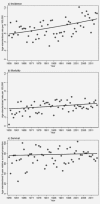Trends in incidence, mortality and survival of penile squamous cell carcinoma in Norway 1956-2015
- PMID: 29205336
- PMCID: PMC5838782
- DOI: 10.1002/ijc.31194
Trends in incidence, mortality and survival of penile squamous cell carcinoma in Norway 1956-2015
Abstract
We examine trends in incidence, mortality and survival of penile squamous cell carcinoma (SCC) in Norway over 60 years. Data on all cases of penile cancer diagnosed in Norway during 1956-2015 were obtained from the Cancer Registry of Norway. Trends in age-standardized rates of penile SCC incidence, mortality and 5-year relative survival were assessed by the annual percentage change statistic and joinpoint regression. A total of 1,596 penile cancer cases were diagnosed during 1956-2015, among which 1,474 (92.4%) were SCC. During 2011-2015, the age-standardized incidence and mortality of penile SCC were 0.91 (95% confidence interval (CI): 0.78; 1.05) and 0.50 (0.42; 0.60) per 100,000, respectively, and the 5-year relative survival was 61.6% (41.9; 76.4). The incidence of SCC increased during 1956-2015, with an average annual percentage change (AAPC) of 0.80% (0.46; 1.15). The increase was strongest among men diagnosed at a relatively early age (age<=64 years; AAPC: 1.47% (0.90; 2.05)). Mortality also increased over the study period (AAPC: 0.47% (0.10; 0.85)), whereas 5-year relative survival did not change (AAPC: 0.08% (-0.19; 0.36)). We conclude that the incidence of penile SCC has increased at a moderate and constant rate during 1956-2015, and that the most consistent increase occurred among younger men. Mortality also increased during the study period. However, survival did not change, thus changes in diagnostics and treatment had little impact on survival from penile SCC. Since a substantial proportion of penile SCC is caused by human papillomavirus (HPV), the incidence increase may in part be attributed to increased exposure to HPV in the population.
Keywords: epidemiology; incidence; mortality; penile cancer; relative survival.
© 2017 The Authors International Journal of Cancer published by John Wiley & Sons Ltd on behalf of UICC.
Figures


References
-
- Barnholtz‐Sloan JS, Maldonado JL, Pow‐Sang J, et al. Incidence trends in primary malignant penile cancer. Urol Oncol 2007;25:361–7. - PubMed
-
- Arya M, Li R, Pegler K, et al. Long‐term trends in incidence, survival and mortality of primary penile cancer in England. Cancer Causes Control 2013;24:2169–76. - PubMed
-
- Baldur‐Felskov B, Hannibal CG, Munk C, et al. Increased incidence of penile cancer and high‐grade penile intraepithelial neoplasia in Denmark 1978–2008: a nationwide population‐based study. Cancer Causes Control 2012;23:273–80. - PubMed
-
- Parkin DM, Bray F. The burden of HPV‐related cancers. Vaccine 2006;24:11–25. - PubMed
-
- Graafland NM, Verhoeven RH, Coebergh JW, et al. Incidence trends and survival of penile squamous cell carcinoma in the Netherlands. Int J Cancer 2011;128:426–32. - PubMed
MeSH terms
LinkOut - more resources
Full Text Sources
Other Literature Sources
Research Materials

